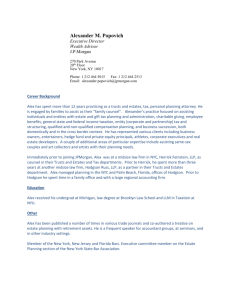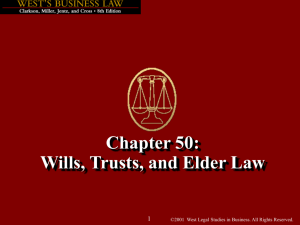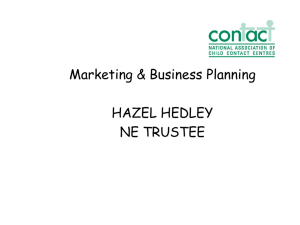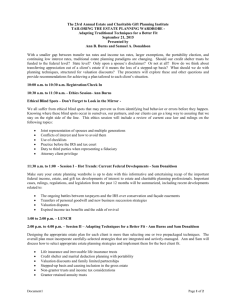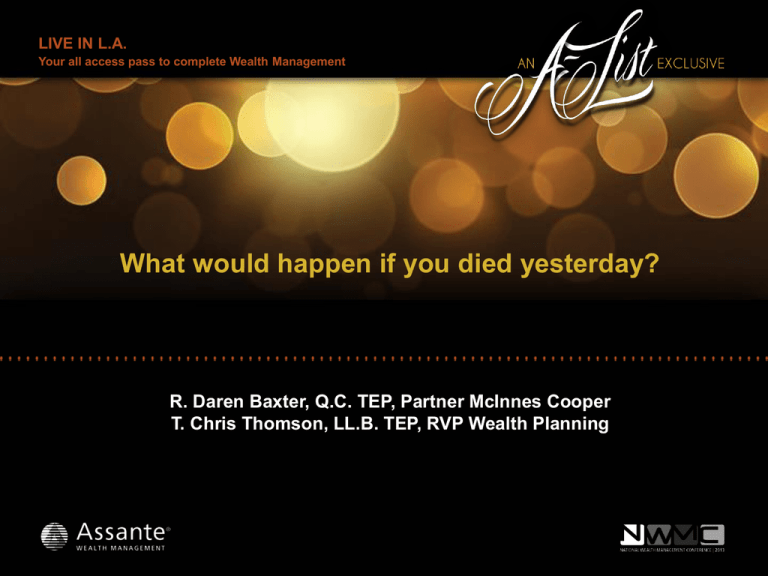
LIVE IN L.A.
Your all access pass to complete Wealth Management
What would happen if you died yesterday?
R. Daren Baxter, Q.C. TEP, Partner McInnes Cooper
T. Chris Thomson, LL.B. TEP, RVP Wealth Planning
Advanced strategies reviewed
• Estate planning for the masses
• Impact of our legal system
• Having an approach
• Testamentary trusts – for most this is the extent of
“advanced”
Advanced strategies reviewed
•
Testamentary trust:
Tax savings high-rate individual (NS)
•
Example: $1,000,000 investment portfolio produces $50,000 income
Outright to high-rate beneficiary:
• $50,000 x 50% (NS):
$25,000 tax
Trust
In testamentary trust instead:
• $10,000 x 1.6% :
• $ 20,000 x 22.70% :
• $ 10,000 x 27.5% :
• $10,000 x 34.50% :
• $50,000 income
• Annual tax saving:
•
$ 160 tax
$ 4,540 tax
$ 2,750 tax
$ 3,450 tax
$ 10,900 total tax
$ 14,100
Beneficiary can still receive the income (net of tax)
Pay income to
beneficiary –
after trust’s
low tax
Beneficiary
Advanced strategies reviewed
Federal testamentary trust proposals
•
•
•
•
Budget 2013 announced intention to hold public consultations on the application of
progressive rates to testamentary trusts and estates
Declared reasoning was neutrality of tax system (compared to tax treatment of inter
vivos trusts) and protection of revenue base (against multiplication of testamentary
trusts, unreasonable estate administration delays, OAS clawback planning)
Finance announced on June 3, 2013 a series of proposals with respect to
testamentary trusts and estates and opened a written consultation process that ends
on December 2, 2013
The proposed measures will apply in 2016 (no grandfathering) and touch upon
several provisions in the Act, not just the application of progressive tax rates
Advanced strategies reviewed
Federal testamentary trust proposals
•
Main change is the elimination of graduated rates – application of current top flat rate
of 29% (rate applicable to income over $135,054 in 2013) – section 122
•
Trusts and estates affected:
– Trusts created by will
– Estates after 36 months of existence (flat top-rate estates)
– Grandfathered inter vivos trusts (pre-June 18, 1971 trusts)
•
Trusts not affected:
– Preferred beneficiary trusts
– Trusts for minor children
•
Trusts created by will or flat top-rate estates will also be forced to have calendar year
taxation years and fiscal periods 104(23)(a), 249(1)
•
Non-flat top-rate estates will have a deemed year end when they become flat top-rate
estates (i.e. after 36 months have expired since date of death)
Advanced strategies reviewed
Federal testamentary trust proposals
•
•
•
•
•
•
•
•
•
•
•
Other tax measures proposed affecting trusts created by will and flat top-rate estates
Quarterly instalment rules will apply 104(23)(e)
AMT basic exemption of $40,000 will be removed 127.53(1)
Part XII.2 tax will apply 210
ITCs will not be able to be allocated by trust to beneficiaries 127(7)
All the above restrictions already applicable to inter vivos trusts
Administrative measures previously only applicable to testamentary trusts will also be
eliminated for trusts created by will and flat top-rate estates
Refunds of overpayment of tax 164(1.5)
Filing of notices of objection 165(1)
Debt forgiveness agreements 80.04(6)(a)(ii)
Reassessments at taxpayer's request 152(4.2)
Advanced strategies reviewed
Federal testamentary trust proposals
•
•
•
Possibility for a trust to distribute assets to beneficiaries on tax-deferred
basis depends on status of the trust as a personal trust - currently, a
testamentary trust is automatically a personal trust. Under the new
proposals, a trust created by will and flat top-rate estates must meet the
same requirements as inter vivos trusts to qualify as personal trusts
Interest in trust not acquired for consideration payable to the trust or a
contributor 248(1)
Proposals confirm that spousal rollovers on death will not be affected
Advance strategies reviewed
• So where does that leave us?
Advance strategies reviewed
• Some might suggest that we are here:
Topics
•
•
•
•
•
•
•
•
Response to proposed testamentary trust rules
Preferred corporate structure
Estate freeze
Wasting freeze
Investment company and 55(2) trap / solution
Alter ego trust / Joint partner trust
Rights and things return
Capital loss carryback
Response to proposed testamentary trust rules
• Don’t lose sight of non-tax reasons for testamentary
trusts
• Plan to continue estate for 36 months to benefit from
marginal tax rates
– Allocation among beneficiaries without immediate
distribution
– Income from allocated assets allocated to specific
beneficiary
– Leave income allocation and timing of distributions to
trustee
Common business structure
• Access to capital gains
deduction likely not
available
• Full capital gain taxed
on death
• Limited creditor
protection
O/M
Company
Business
Portfolio
Preferred corporate structure
•Surplus cash moved to
Investco as tax free intercorporate dividend as earned
Trust
•Investment assets separated
from business risks
Common
shares
•Shares of Opco QSBC
•Individual has only contingent
interest in trust
Opco
•Nothing for creditors
•No value in hands to be taxed
upon death
Business
Investco
Discretionary
dividend
shares
Portfolio
Estate freeze
• Preferred
shares required
to effect estate
freeze on tax
deferred basis
• Existing value
remains in
hands of O/M
• Future growth
to Trust
O/M
Trust
Opco
Investco
Business
Portfolio
Wasting estate freeze
• Use “wasting
shares” for freeze
• Pay dividends first
on Investco
preferred shares
• Next, waste
company shares
to CGD limit
O/M
Trust
Company
Investco
Business
Portfolio
Wasting estate freeze
• By death:
– No preferred
shares of
Investco
– Company
preferred shares
sheltered by
CGD
– All residual value
in Trust
O/M
Trust
Opco
Investco
Business
Portfolio
Common plan - 55(2) divisive reorganization
trap
Child
Upon death of
parents, trust
assets divided
among children
Child
Child
Family
Trust
Investco
Portfolio
Child
55 (2) divisive reorganization trap
Children will want to
separate their
interests into
separate
companies
55(2) will deny tax
deferred
separation
Child
1
Child
2
Investco
Portfolio
Child
3
Child
4
55(2) divisive reorganization (“butterfly”) rules
• Inter-corporate dividend to newcos on divisive
reorganization treated as capital gain where
– Inherent gain in corporate assets
– Otherwise tax free inter-corporate dividend (including
deemed dividend on redemption)
– Transaction otherwise results in reduction of capital
gain, but for inter-corporate dividend
– An unrelated persons obtains an increased interest in
any company
• 55(5)(e) – siblings are not related for this rule
Planning opportunity - effect division
reorganization during parent’s life
• Separate trust for
each child,
controlled by parent
• Each company has
¼ interest in
portfolio
• Nominee
corporation controls
portfolio
1
2
3
4
Corp 1
Corp 2
Corp 3
Corp 4
Portfolio
Alter ego trust / Joint partner trust
• Alter ego trust
– Settlor must be 65 years old
– Settlor entitled to all income of the trust prior to death
– No person other than settlor entitled to income or
capital prior to death of settlor
– No election filed not to be alter ego trust
• Joint spousal or common-law partner trust
– As above, but both settlor and spouse / common-law
partner entitled to income prior to later death and no
one other than settlor and spouse / common-law
partner entitled to capital prior to later death
Alter ego trust / Joint partner trust
• Taxation
– Assets roll into trust on a tax deferred basis
– Trust taxed as inter vivos trust
• If 75(2) applies, tax attributes to settlor
– Deemed disposition at FMV in trust on last death
• Common uses
–
–
–
–
–
–
Incapacity planning / Continuity of control
Inter vivos creditor protection
Avoid estate litigation
Privacy
Probate tax avoidance
Technique to move situs of assets
Alter ego trust / Joint partner trust
O/M
Alter
ego
trust
• Preferred
shares rolled to
Alter ego trust
or Joint partner
trust
Trust
Company
Investco
Business
Portfolio
Private company planning - probate tax
• Constitution Act, 1867 limits taxation authority of
province to direct taxation within a province
– Probate tax on property may only be applied to property within
the province
• Shares are situate in the jurisdiction where they may be
effectively dealt with as between the company and the
shareholder
– Normally where the share transfer register is maintained
as required by corporate legislation
• CBCA allows registered office to be situate
anywhere in Canada
– Alberta probate tax maximum $400
Private company planning – Rights & Things
return
• Separate return may be filed for rights & things of
taxpayer owned at time of death
– May claim another set of personal tax credits
• Alternatively, the right or thing may be transferred in
kind to a beneficiary on a rollover basis
– Within time for filing separate return
– Beneficiary taxed when rights & things actually
realized
Private company planning – Rights & Things
return
• Rights & Things include:
– Declared but unpaid dividends, unused vacation
leave credits, work in progress of most professionals,
and inventory of many farmers
• Planning opportunity – declare but do not pay a
dividend until after death of taxpayer
– Dividend taxable only when becomes payable
– File a separate return for rights and things
– Benefit of marginal rate (tax savings of $10,000 on a
$30,000 dividend in Nova Scotia)
Can the costs of probate/estate tax be added to
the ACB of capital property causing a larger
loss to carry back to terminal year?
• Brosamler (2012 TCC 204) – Taxpayer successful in
increasing ACB of real property in estate by pro-rata
amount of probate and legal fees. Increased ACB
increased the capital loss carried back to the estate.
– Necessary to incur probate fees to sell the property
• CRA Round Table 2012 Ont. Tax Conf. Q.17 –
Brosamler unique in its facts. Whether estate taxes
incurred outside of Canada will increase ACB will
depend upon the facts.
Loss reduction where gain in the estate
following a loss on the redemption of shares
• Capital loss carryback is ground by loss denial rules
• CRA Roundtable 2012 Ont. Tax Conf. Q. 14 – If the
estate realizes gains during the first taxation year,
those gains must be applied against the loss on
share disposition…will result in amount of loss
stopped by 40(3.61)…which reduces the 164(6)
election.
• Solutions: (1) Avoid gain in first tax year of estate; or
(2) Distribute property to beneficiaries on a rollover
basis under 107(2) prior to sale
Questions?
Thank you
For advisor use only
This material is general in nature and subject to change without notice. Every effort has been made to
compile the information from reliable sources however no warranty can be made as to its accuracy or
completeness. Before acting on any of the information contained herein, please seek professional advice
based on your personal circumstances. Services and products may be provided by an Assante Advisor or
through affiliated or non-affiliated third parties. Insurance products and services are provided through
Assante Estate and Insurance Services Inc.
Assante is an indirect, wholly-owned subsidiary of CI Financial Corp. (“CI”). The principal business of CI is
the management, marketing, distribution and administration of mutual funds, segregated funds and other
fee-earning investment products for Canadian investors through its wholly-owned subsidiary CI
Investments Inc. If you invest in CI products, CI will, through its ownership of subsidiaries, earn ongoing
asset management fees in accordance with applicable prospectus or other offering documents.
© 2013 United Financial, a division of CI Private Counsel LP. All rights reserved.




